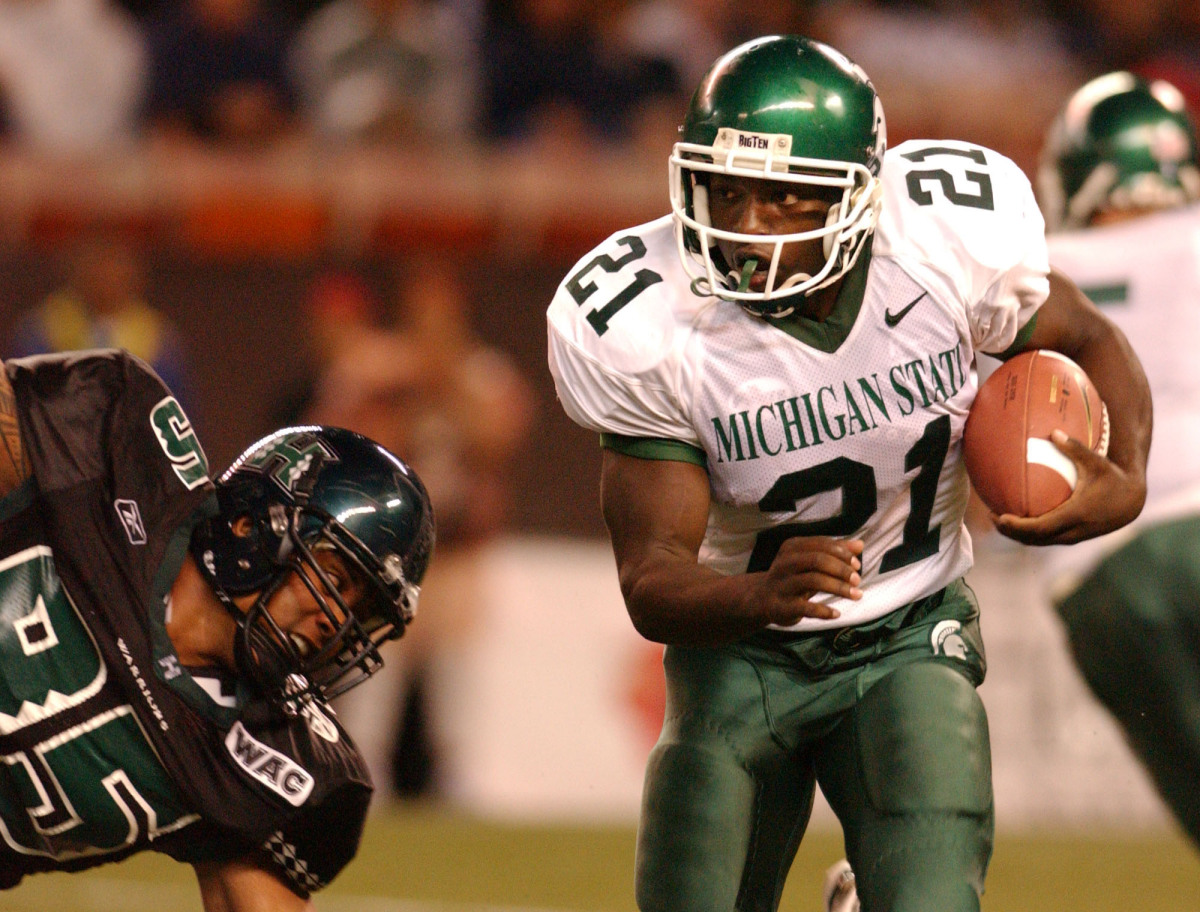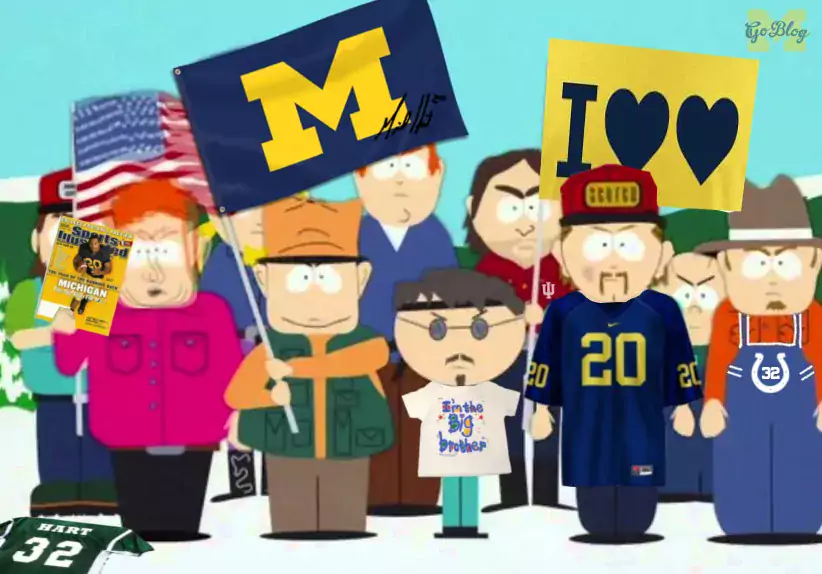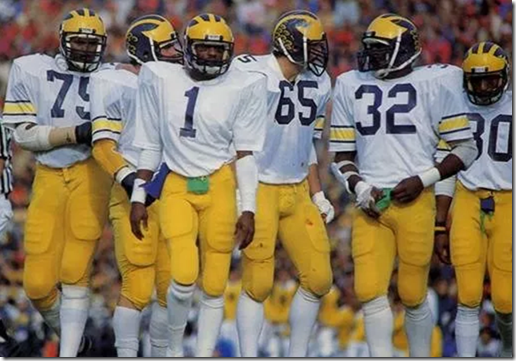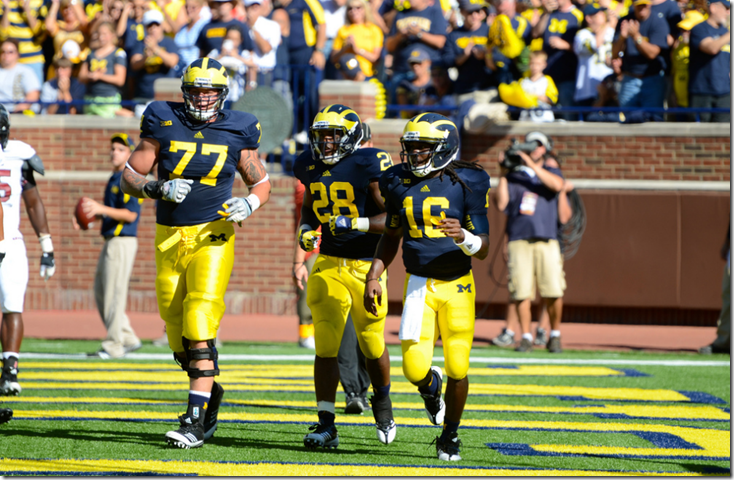lamarr woodley

A couple weeks back I put a post on the MGoBoard about an upcoming series I was planning that would be revisiting great games in Michigan Football history, told by someone who had never seen the game before (me) using insight from someone who had (Craig Ross). This is the first piece in that series and it revisits the most recommended game in the thread I put up... 2004 Michigan State also known as "Braylonfest".
The team: The 2004 Michigan Football season saw a changing of the guard at the two most prominent positions of the era, with the graduations of QB John Navarre and RB Chris Perry in the offseason. In stepped the true freshmen who would define the program over the next four seasons, Chad Henne and Mike Hart. Though being a true freshman starting QB is quite difficult, having returning production in the passing game helped Henne. It especially helped to have a superstar to throw to in Braylon Edwards. Coming off an 1100 yard, 1st Team All-B1G season in 2003, Edwards would be the star of the season and of this game. Fellow wideouts Jason Avant and Steve Breaston also returned, as did TE Tim Massaquoi, meaning four of the top five players in receiving yards in 2003 returned for '04 and were at Henne's disposal (Perry was the other).
On the offensive line, starters returned at LT (Adam Stenavich), LG (David Baas), and RG (Matt Lentz). The team graduated All-B1G C Dave Pearson and RT Tony Pape, plugging Mark Bihl into the C spot and RS Fr Jake Long into the RT spot. By the time this game rolled around, Bihl had been injured, with Baas sliding to center and Rueben Riley taking over LG. Kevin Dudley returned as fullback for his senior season, while David Underwood and Jerome Jackson returned to the 2004 squad at RB, though Hart got the vast majority of the carries (Max Martin was on the depth chart as a freshman as well in '04).

[Bentley Historical Library]
The defensive side of the ball was led by star corner Marlin Jackson, the team's lone defensive All-American (1st team). Opposite him at corner was Markus Curry to start the season, eventually supplanted by sophomore Leon Hall. The safeties were a duo of Ryan Mundy at FS and Ernest Shazor at SS, the latter a hero the week before this game. Scott McClintock manned the middle at MIKE LB, while Lawrence Reid was the starter at WILL. Neither LB earned postseason honors and this game will provide a decent window into why.
Along the defensive line, the gargantuan (6'8") Pat Massey and Gabe Watson, a fellow junior, started for the Wolverines. Watson earned 1st/2nd Team All-B1G for his work that season and they were joined by sophomore OLB/EDGE LaMarr Woodley, who earned 2nd Team All-B1G. Rotational pieces down along the defensive line included Larry Harrison and Alex Ofili, among others. At special teams, Garrett Rivas was a sophomore at kicker (his second season of starting duty), while Adam Finley was a senior at punter, his third and final year as the starter. Steve Breaston handled returns for the Wolverines.

[Ronan Silberman/AP]
The opponent: Michigan State was in year #2 of the John L. Smith era in 2004. They had gone 8-5 the previous season, ending the year with a loss to Nebraska in the Alamo Bowl. Multi-year starter at QB Jeff Smoker had graduated, with Drew Stanton taking over command of the offense in '04. He was given reasonable stability at the skill positions but a defense that would take a sizable step backwards in 2004 relative to the prior year. The Spartans went 1-2 in non-conference to start the season, with losses at home to Notre Dame and at Rutgers, but strung together strong results to open the B1G slate. They knocked off Indiana, lost at Kinnick to Iowa, but then defeated Illinois and ranked Minnesota at home to situate themselves at 3-1 in the conference heading into the bye week, prior to this game (4-3 overall).
[AFTER THE JUMP: The game and my takes on it]

Ty Law's in the Hall of Fame. Tom Brady's the GOAT. And a bunch of former Michigan players just had their first go in the new AAFL. So I'm making a 53-man pro team out of Michigan alumni.
Previously:
- Ancient History: 1879 to 1968
- All-Pro Team: Offense
- The 5-stars
- The 3-stars
- The Extracurriculars
- Position-Switchers
- Highlights
- All-Numbers Team Part I: The Offense
- All-Numbers Team Part II: The Defense
- The Best of Michigan (the state)
- All-Name Team
- All-Small Team
Rules are the guy's Michigan career is irrelevant except he has to have at least been on the field for Michigan—this is all based on how good he was as a pro. Pro Bowls, starts, and longevity are more important than team success. It's also not simply a list of the greatest pros—I'm building a team. I already did the offense. Here's Part II.
-----------------------------------------
Defensive Tackle: Tom Keating (1964-'75)
Start about 5:28 and watch #74
Tom Keating played nose tackle for some of the greatest teams of the '60s and '70s, and was the fulcrum for one of the nastiest (and most successful) defenses in the history of the game. Keating's claim to fame at Michigan is he was the first Michigan player to touch the banner while captaining the defensive line for Bump's worst two teams.
Keating's pro career started slowly. Drafted by the Vikings (NFL) and the Bills (AFL), Keating chose the latter as they were one of the premier teams in the game. That proved a mistake, as Keating relegated to a rotation spot on a stacked Bills roster (they were AFL Champions his first, second, and fourth years in the league).
Keating walked in 1966, and joined the Raiders. He was an immediate AFL All-Star, and by his second season in Oakland Keating was celebrated as the Aaron Donald of his time, anchoring a legendary Raiders defense that dominated the end of the 1960s. Except for the one season (1968) Keating missed with a leg injury, he was the premier DT in the league, and when the AFL merged with the NFL, he was the best in either. Their best defense was probably in 1970, the first year after the merger. But that was the year all of the Raiders' quarterbacks got injured and they had to re-sign kicker George Blanda to play quarterback. The injuries finally caught up in 1973 in one year mentoring what would become the front of the Steel Curtain. Keating's last great year was 1974 with the Chiefs, and he retired after 1975.
[After THE JUMP: One that got away]

Last offseason I was making these Michigan All-____ Teams and I didn't get around to all of the ideas. So let's.
Previously:
- Ancient History: 1879 to 1968
- The 5-stars
- The 3-stars
- The Extracurriculars
- Position-Switchers
- Highlights
- All-Numbers Team Part I: The Offense
- All-Numbers Team Part II: The Defense
- The Best of Michigan (the state)
- All-Name Team
Today's Rules: You must be in the bottom quartile of height for your position and get extra points for being shorter than that. Weight doesn't matter as much as height (because most of these guys had to add a lot of it). Also this has to be relative to the players of your era—with a heavy recency bias—because there was a time when a six-foot offensive tackle was considered huge. For example, here's 5'11" Anthony Carter with some of the other 1979 offensive starters (via a Dr. Sap article on MVictors):
I'm going to use my discretion as we go, but if a player wasn't remarkably tiny for his era, even if he would be in ours, he doesn't count.
The problem: Rosters lie, especially regarding these players, because listing a short guy at his real height could depress his pro future. Where I have knowledge of a guy's actual height I'll use that, and beyond that I'm just going to do my best.
Quarterback: Denard Robinson
Last listed size: 6'0"/197 (2012)
[Brian Fuller]
Strangely, 2019 recruit Cade McNamara, at 6'1", is the third-shortest Michigan scholarship quarterback since Bo, with Denard and 2008 proto-Denard Justin Feagin both listed at a straight six. Or maybe that's not so strange because height in a quarterback is so highly valued. In my opinion it's highly overrated; the last two Heisman winners were Oklahoma quarterbacks listed at 6'0" and 5'11", QED. Notably, despite Michigan's clear preference for tall guys, some of their best were all on the shorter side, including Chad Henne and Shea Patterson, both just 6'2". Anyway, the rosters lied about Denard's height, which was probably 5'11" or just under it. I should mention the 2011 roster lists Denard as 5'9", which is wrong but feels right. His height led to a few batted balls, but since his center also appears later on this list (and Ricky Barnum wasn't very tall either), and because defenders in space had to approach warily lest Denard escape the pocket, the % of batted balls from Denard in the UFRs is lower than that for Henne.
Honorable Mention: Dennis Brown (5'10"/175), Tate Forcier (6'1"/190), Harry Newman (5'7"/174), Boss Weeks (5'7"/161) lots of other old dudes. Michigan's first great quarterback (and college athletics' first great athletic director) Charles Baird was listed at 5'6". Michigan's shortest QB on the Bentley database was 1914-'16 bencher Harold Zeiger, at 5'4".
[After THE JUMP: Not who you think]


72